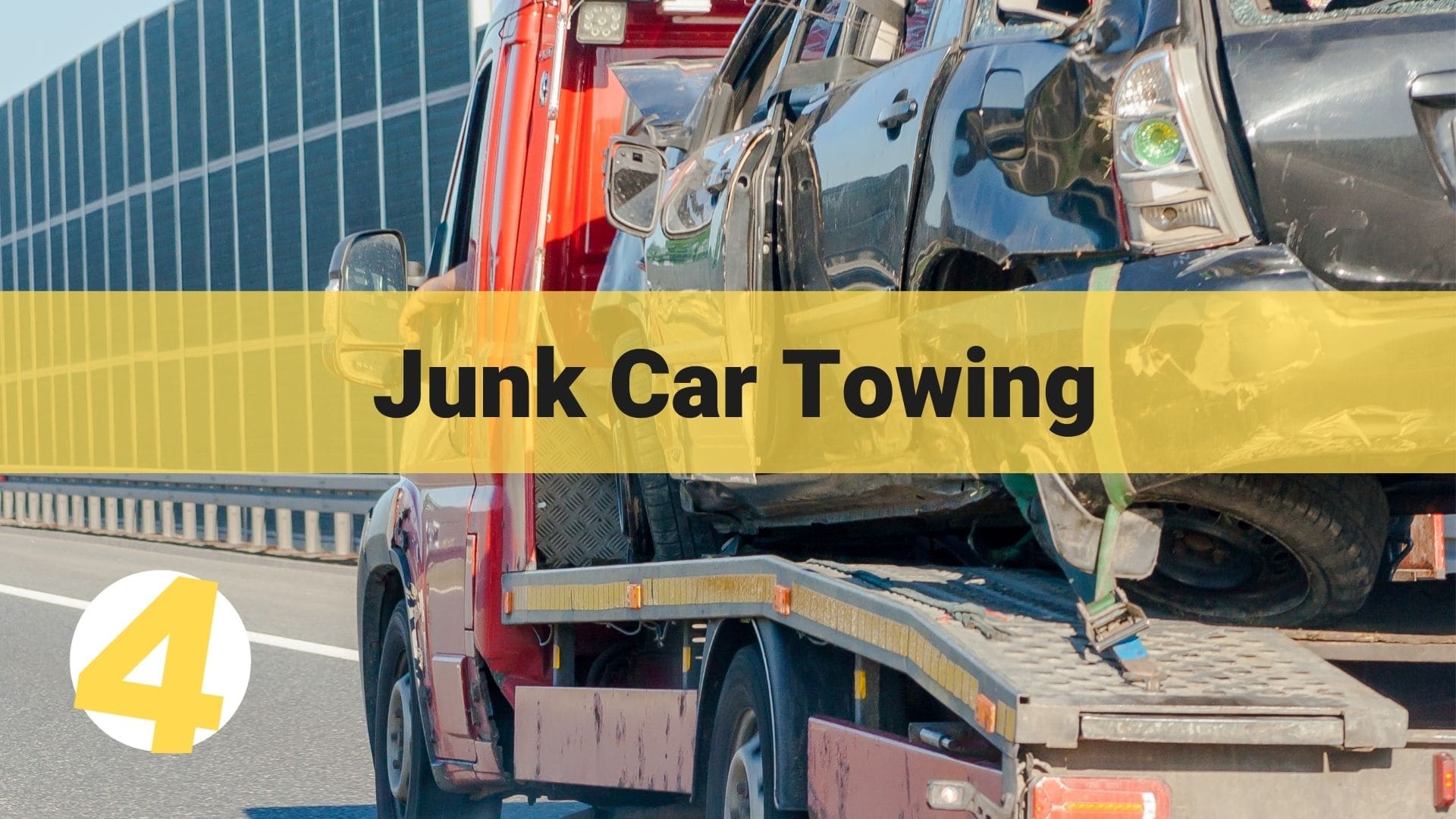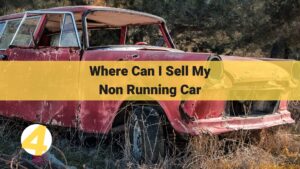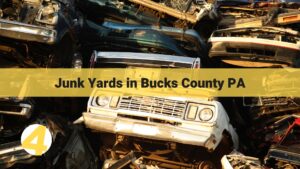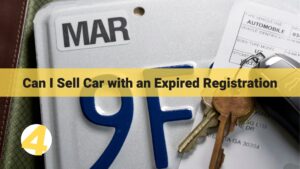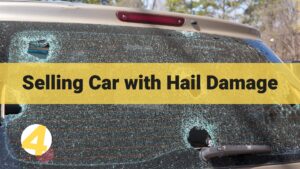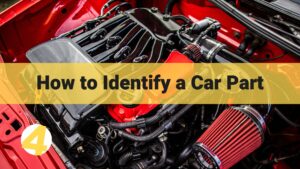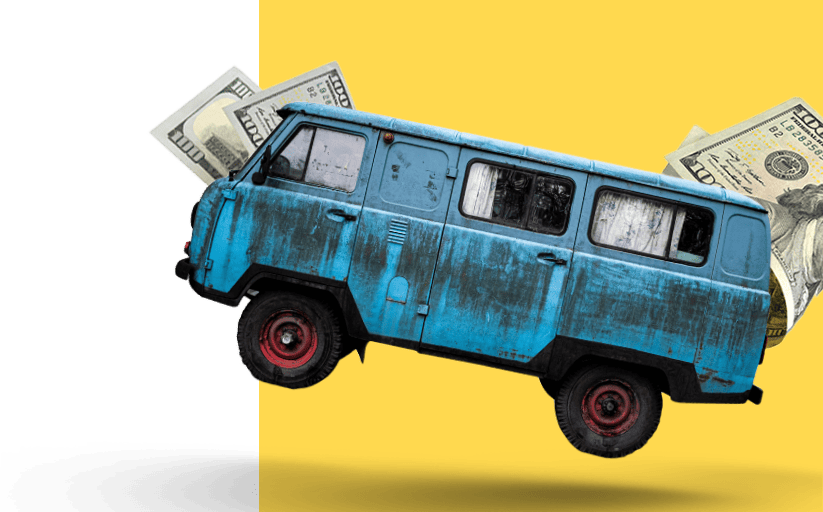Junk car towing involves safely transporting inoperative or old vehicles from one location to another, often for disposal or recycling. Proper preparation, secure attachment, and understanding of different towing methods are essential for this process.
Continue reading for a step-by-step guide on how to effectively and safely tow junk cars.
Preparation for Towing Your Junk Car
Good preparation ensures safety, prevents potential damages, and streamlines the towing process.
Assessing the Condition of the Junk Car
Before towing, inspect underneath the car for any oil, coolant, or other fluid leaks. Inspect the tires. While the car may be junk, having tires in a reasonable state can ease the towing process. If they are flat or damaged, consider replacing them temporarily or using other towing methods. It’s also important to ensure the car is empty of any personal belongings. If possible, ascertain the car’s weight as it can influence the towing method.
Checklist of Essential Items and Tools
- Tow Straps or Chains. To attach the car securely.
- Toolkit. For any last-minute repairs or adjustments.
- Jumper Cables. In case the car needs a jump start to shift gears.
- Wheel Chocks. To prevent unwanted movement.
- Documentation. Necessary paperwork related to the junk car.
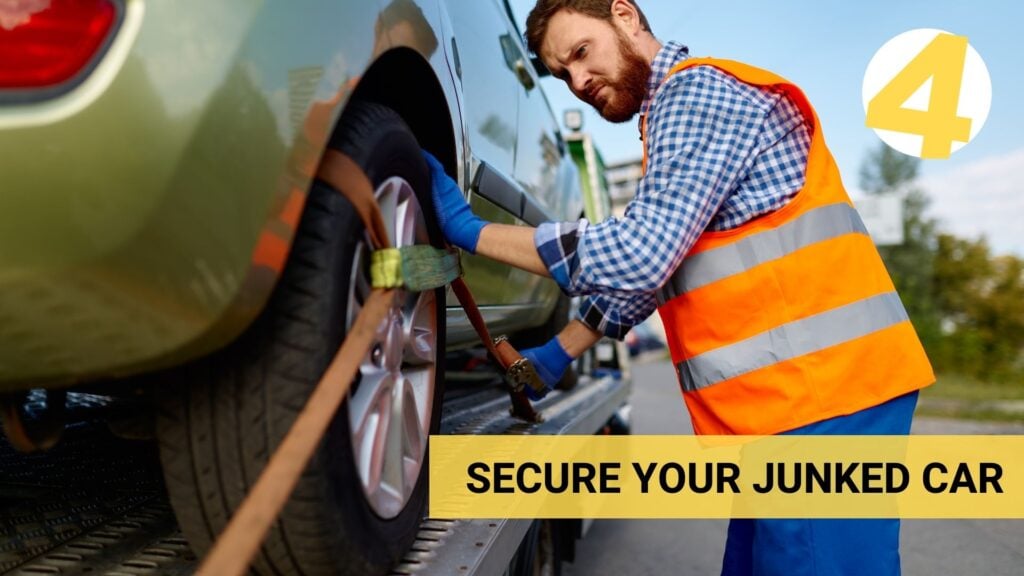
Securing the Junk Car
Securing the vehicle is a non-negotiable step in the towing process. A poorly secured junk car is not only a danger to you but also to other road users. Unexpected shifts in the vehicle’s weight can destabilize your towing setup and may cause accidents. Furthermore, a vehicle that’s not securely fastened can become completely detached and pose significant risks on the road.
Attaching Tow Straps or Chains Correctly
Tow straps and chains are the lifelines when towing a junk car. Their proper attachment is crucial for a safe towing experience. Here’s how to do it:
- Choose the Right Equipment. Make sure the tow straps or chains are rated for the weight of the car you’re towing.
- Inspect for Damage. Before use, always check your tow straps and chains for any signs of wear or damage. Frayed straps or rusted chains can break under tension.
- Attachment Points. Attach the tow straps or chains to the designated towing points on the junk car. Most cars have these points on their front and rear. Avoid attaching to parts like the bumper or axles, which may not hold up under pressure.
- Secure the Hooks. Once the straps or chains are in place, ensure that their hooks are securely fastened. A half-attached hook can easily slip off during towing.
- Avoid Twisting. Ensure the straps or chains lie flat without any twists. Twisted straps or chains can weaken and break under tension.
Setting the Vehicle for Towing
Before setting off, it’s crucial to prepare the junk car itself for the process.
Neutral Gear
Ensure the vehicle is in neutral. This prevents damage to the car’s transmission and makes it easier to tow.
Unlock the Steering
The vehicle’s steering should be unlocked. If towing using a dolly or tow bar, this allows the front wheels of the junk car to turn and follow the direction of the tow vehicle.
Engage the Parking Brake
Only if you’re using a flatbed towing method, engage the parking brake of the junk car once it’s on the flatbed. This provides an added layer of security.
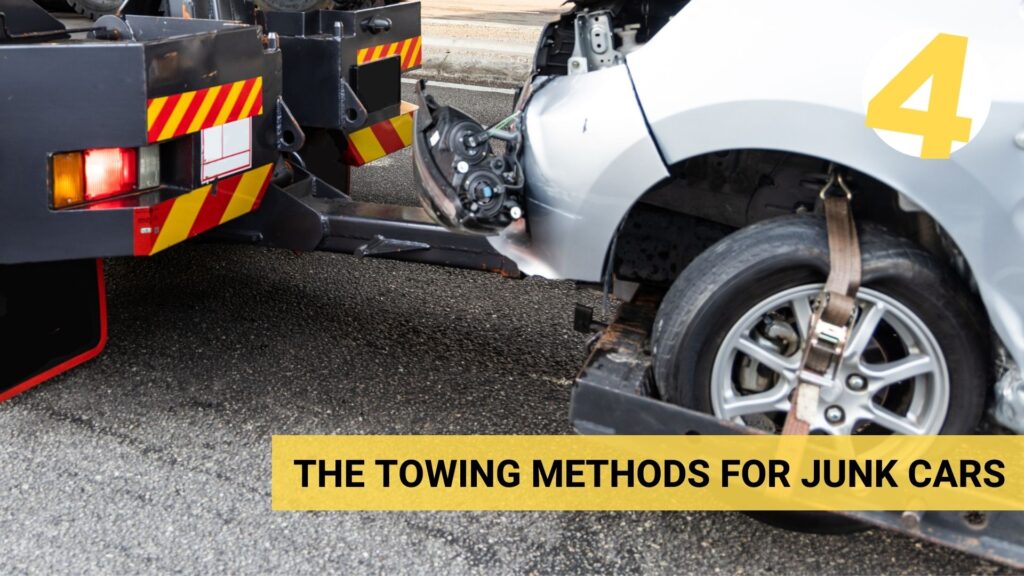
The Towing Methods for Junk Cars
Towing isn’t a one-size-fits-all operation. The method you choose is crucial and will depend on the type of junk car you’re towing, its condition, and your available resources.
Flatbed Towing
Flatbed towing involves a truck with a flat surface or bed. The junk car is loaded onto this bed to make sure all four wheels are off the ground. It’s widely considered the safest method of towing.
To do this, align the flatbed truck in front of or behind the junk car, depending on where you’ll load the car. Use the truck’s controls to lower its bed to ground level. If the junk car is operable, drive it onto the flatbed. If not, use a winch to pull it.
Once loaded, use chains or straps to secure the vehicle firmly to the flatbed, ensuring it won’t move during transit. Elevate the flatbed to its original position and make sure the junk car is steady.
This method is ideal for cars in very poor condition, those without functioning wheels, or those with potential fluid leaks. The car is entirely off the ground, so there’s no wear or strain on any part of the junk vehicle.
Dolly Towing
A tow dolly lifts the front wheels of the junk car off the ground while the rear wheels remain on the ground and roll during towing.
This is done by first connecting the tow dolly to the towing vehicle’s hitch. Drive or push the junk car’s front wheels onto the dolly. Use chains or straps to attach the car’s front wheels securely to the dolly. Ensure the dolly’s ramp is locked in an upright position.
Tow dollies are best suited for front-wheel-drive cars. However, it’s not ideal for very large vehicles or those in a severely dilapidated state. The junk car’s rear wheels should be in decent condition as they’ll be in contact with the road.
Tow Bar Towing
A tow bar is a triangular metal device that attaches to both the towing vehicle and the junk car. It allows the car to roll on all four wheels during transport.
First off, securely fasten the tow bar to the towing vehicle’s hitch. The other end of the tow bar should be attached to the junk car’s front towing points. Always use safety chains as a backup. Connect them between the junk car and the towing vehicle. Ensure the junk car’s steering is unlocked to allow it to follow the towing vehicle smoothly.
Tow bars are versatile and can be used for many junk cars. However, the car’s condition is crucial. All its wheels must be in a state where they can roll, and its weight shouldn’t exceed the tow bar’s capacity.
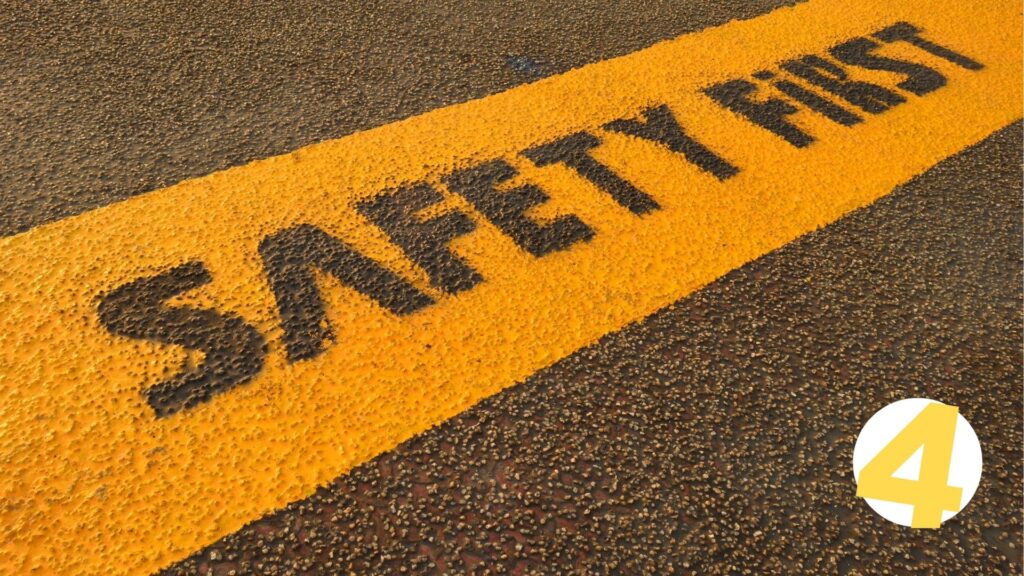
Safety Precautions in Towing Junk Cars
Safety should always be the top priority when towing junk cars. Given the unpredictable nature of aged or damaged vehicles, unexpected issues can arise. Being well-prepared and mindful of safety protocols can help you avoid accidents and ensure a smooth towing experience.
Key Safety Measures During Towing
1. Wear Safety Gear
- Safety Vests. Especially if you’re towing at night or in low-visibility conditions, wearing a high-visibility safety vest ensures you’re easily seen by other motorists.
- Gloves. Handling chains, tow straps, and metal parts can be tough on the hands. Wearing gloves can prevent cuts, scrapes, and other injuries.
2. Use Proper Signaling
- Tail Lights. Ensure the junk car’s tail lights or the towing equipment’s lights are functional. They signal your movements to drivers behind you.
- Turn Signals. Always use turn signals well in advance before making a turn or changing lanes.
- Hand Signals. If any electronic signals fail, be prepared to use hand signals to indicate your intentions.
3. Maintain Safe Distances
Given the additional weight you’re hauling, your vehicle’s braking distance will increase. Always maintain a safe distance from the vehicle in front of you.
4. Check Attachments Regularly
Pull over safely, and check all attachments, chains, and straps to ensure they are secure periodically, especially during long tows.
5. Avoid Sudden Maneuvers
Quick turns, abrupt lane changes, or sudden stops can destabilize your setup. Always make movements gradual and predictable.
Handling Common Towing Challenges
Hills and Slopes
When moving uphill, maintain a steady speed. While descending, use a lower gear to leverage engine braking and reduce strain on your brakes.
Sharp Turns
Approach turns slowly and give yourself plenty of room. Remember, the junk car will track inside the turn, so avoid cutting corners too closely.
Breakdowns
If the towing vehicle breaks down, ensure you move both vehicles safely off the road. Use hazard lights and set up reflective triangles to alert other road users.
Unfamiliar Terrains
If you’re towing on unfamiliar roads or off-road, scout ahead when possible. This can help you anticipate challenges and navigate them safely.
Weather Challenges
In wet or icy conditions, increase your following distance. If visibility is low due to fog or heavy rain, consider postponing the tow or finding a safe spot to wait it out.
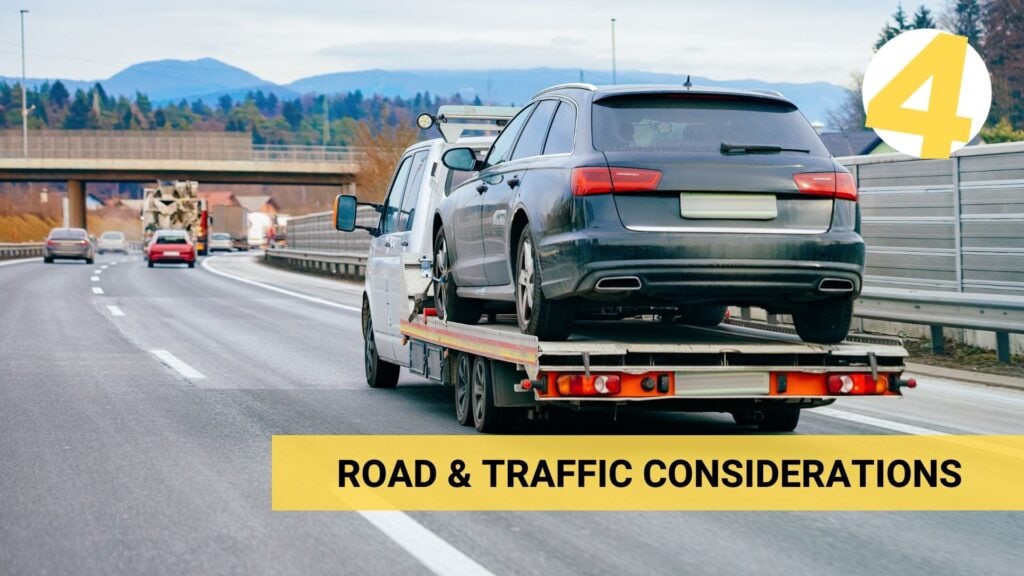
Road and Traffic Considerations
When towing a junk car, you’re not merely driving your own vehicle but managing the combined dynamics of two vehicles. This unique challenge makes it essential to be extra mindful of road conditions, traffic rules, and other road users.
Awareness of Road Conditions and Traffic Rules
Towing amplifies the challenges posed by road conditions. Potholes, bumps, or slippery patches can have exaggerated effects on a towing setup. Being aware of the road ahead allows you to make timely adjustments to ensure safety. Equally essential is adherence to traffic rules. While these rules are fundamental for all drivers, their importance is magnified when towing due to the added risks involved.
Driving Speed, Lane Choice, and Unexpected Situations
Driving Speed
Even if the speed limit allows for faster driving, it’s advisable to drive below the maximum limit when towing. This ensures better control and reduced stopping distances. Avoid rapid accelerations or decelerations. A consistent speed ensures stability, especially on highways.
Lane Choice
Stay in the right lane. On multi-lane roads, especially highways, the rightmost lane is often the best choice for towing. It allows for a slower speed and provides easier access to exits. If you must overtake, do so with ample clearance and return to your lane smoothly.
Handling Unexpected Situations
In case of an unexpected event, like debris on the road, brake steadily. Avoid abrupt stops, which could lead to skidding or jackknifing. If you experience a tire blowout, maintain your steering and reduce speed gradually. Avoid sudden maneuvers.
Documents and Permits for Towing
Towing License
Some jurisdictions require a special license or an endorsement to your regular driving license to tow above a certain weight. Ensure you’re compliant.
Permits
Depending on where you are, you might need specific permits, especially if the junk car is significantly large or if you’re crossing state or national boundaries.
Insurance
Before towing, check your insurance policy. Does it cover towing? If not, consider an upgrade or a temporary policy that provides coverage during the tow.
Vehicle Documentation
Even though the car is junk, have its documentation at hand. This includes the title, registration, and any other relevant paperwork.
Safety Inspection Certificates
In some places, a safety inspection might be required before towing a vehicle, even a junk one. This is to ensure the vehicle won’t pose risks on the road.
Route-specific Permits
If your route includes tunnels, bridges, or toll roads, check if there are any restrictions or special permits required for towing vehicles.
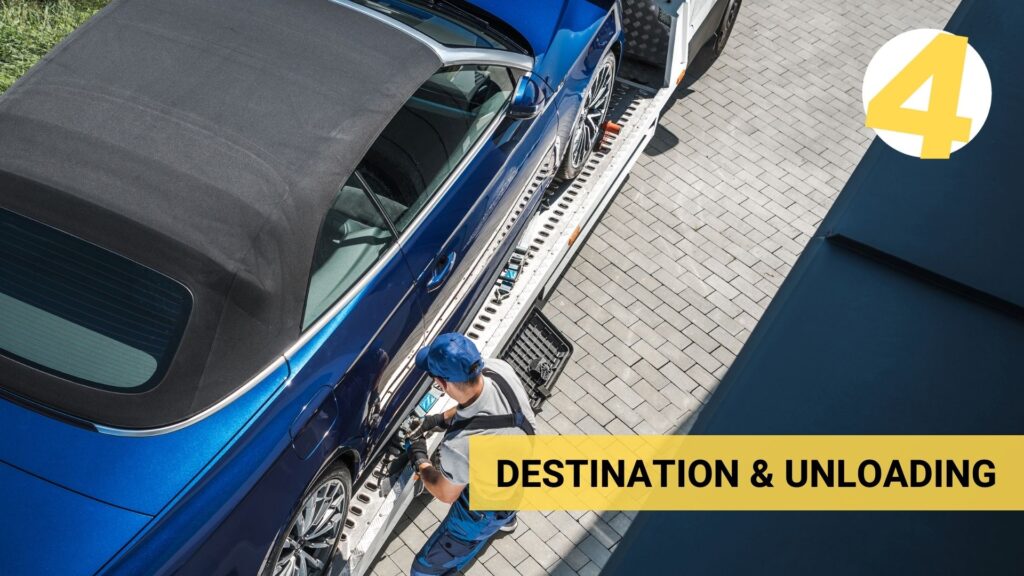
Destination and Unloading
Once you’ve arrived, there are specific considerations and steps to follow to ensure the vehicle is unloaded safely and left in an appropriate manner.
Reaching the Destination Safely
Before you begin your tow, have a clear idea of where you’re headed. Using a GPS or map can guide you to the most accessible route and help avoid any unforeseen obstructions. As you near your destination, reduce your speed. This allows you ample time to spot any potential hazards in the unloading area.
Ensure the unloading area has firm, even ground. Soft or uneven surfaces can lead to complications during the unloading process. Once you’ve positioned your towing vehicle and the junk car, engage the parking brake on both. This prevents any unwanted movement during the unloading process.
Safely Unloading the Junk Car
Before starting the unloading process, wear gloves to protect your hands and safety shoes to prevent foot injuries. Begin by carefully releasing any tension in the tow chains, straps, or cables. Remove them in the reverse order you attached them. If available, have someone guide you as you reverse or move the junk car off a flatbed or dolly. Their perspective can help avoid any misalignment or potential scrapes.
If you’ve used a tow dolly or similar equipment, ensure the car is lowered gently and steadily to prevent sudden jolts. Before driving the towing vehicle away, double-check that all towing equipment is clear of the junk car.
Considerations for Leaving the Vehicle at its Destination
- Positioning the Car. Ensure the junk car is left in a manner that doesn’t obstruct pathways or entrances. If you’re leaving it at a junkyard or recycling facility, follow their specific guidelines.
- Removal of Valuables. Even if the car is designated as “junk,” check its interior for any personal belongings or items of value before leaving.
- Lock the Vehicle. Lock all doors to prevent unauthorized access, especially if the vehicle is being left in a public or unsecured place.
- Documentation Handover. If you’re leaving the car at a facility where it will be scrapped or sold, ensure you hand over all relevant documentation and keep copies for your records.
- Note the Condition. Take photos or notes about the vehicle’s condition upon arrival. This can be helpful in the event of disputes or for your own records.
- Notification. If required by local laws or the destination facility’s rules, notify the relevant authorities or management about the vehicle’s arrival and its details.
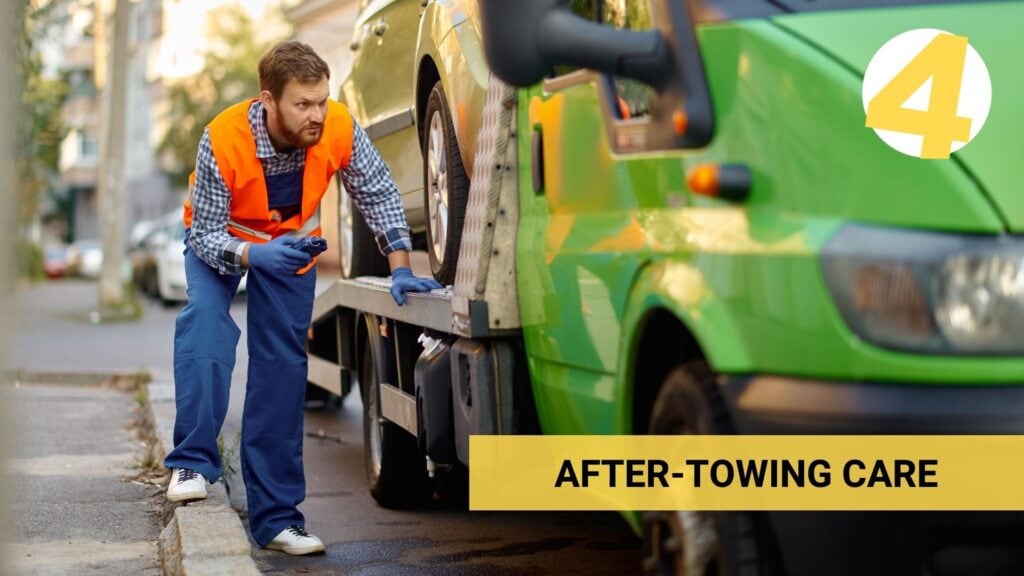
After-Towing Care
It’s essential to give due attention to the post-towing phase, ensuring that all equipment is well-maintained, appropriately stored, and any legalities or disposals are adequately addressed.
Importance of Post Junk Car Towing Maintenance and Inspection
Regular inspection and maintenance of your towing equipment ensure a longer lifespan, saving you replacement costs in the long run. Any wear and tear or damage to the towing equipment can compromise its effectiveness and safety in future uses. Regular checks can help identify and rectify these issues promptly.
Well-maintained equipment performs better. It ensures that your next towing task is completed efficiently without hitches or unexpected complications. Addressing minor issues promptly can prevent them from escalating into more significant, costlier problems.
Storing or Disposing of Towing Equipment
Before storing, it’s advisable to clean the equipment, removing any dirt, grease, or debris. This prevents corrosion or damage. Store your towing equipment in a dry place. Exposure to moisture can lead to rust, which can weaken the equipment. Even while in storage, occasionally inspect your equipment for any signs of damage or wear and tear.
If a piece of equipment is damaged beyond repair:
- Recycle. Check if any parts can be recycled.
- Dispose Properly. Ensure safe disposal according to local regulations, especially for parts that may be environmentally hazardous.
Handling Legal or Disposal Requirements
Always maintain records of your towing activities, including dates, locations, and the vehicles involved. This can be crucial for any future legal or insurance purposes. In some jurisdictions, it’s necessary to notify local authorities after towing a junk car, especially if it’s destined for scrapping or recycling. If the junk car is sold or given away, ensure all paperwork for the transfer of ownership is completed and filed correctly.
If you’re disposing of parts or fluids from the junk car, do so in an environmentally responsible manner. Many localities have specific centers for disposing of automotive wastes. Laws and regulations related to towing and vehicle disposal can change. Regularly update yourself on local regulations to ensure you remain compliant.
The Next Best Step to Your Towing Journey!
Every step of junk car towing, from pre-towing preparations to post-towing care, is essential for a safe and successful towing experience. But what’s next after your car has been safely towed?
This is where you can consider making cash for junk cars. And this service is our expertise at Cash4Cars. As a reputable, licensed, and insured company, we provide a seamless solution for those looking to dispose of their junk cars.
No more concerns about transportation – our Free Pickup service means our experienced team comes straight to you. And what truly sets us apart is our unique ‘Get Paid On The Spot’ policy. After a swift inspection, instant payment is made, putting cash in your hand immediately.
So, if you’ve just towed your old car and are contemplating the next steps, let Cash4Cars simplify the process. Enjoy unparalleled customer service, straightforward pricing, and the satisfaction of turning your junk car into instant cash.

